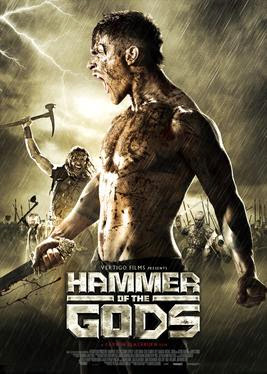 |
| Copyright: Magnet Releasing |
To be honest, I didn’t expect much from this film. The trailer I saw a few months back looked like something I saw many times, starting with The 13th Warrior, and right up to the History Channel’s Vikings. But, Hammer of the Gods managed to sunrise me. It’s a low budget movie, it’s all action and adventure, but done in a very smooth manner.
It looks to me that Farren Blackburn, the director, alongside Matthew Read who wrote this movie, did a lot of research on the subject of modern depiction of the Viking culture. They made a simple plot, in which a young Nordic prince named Steinar arrives in England in 871, as a vanguard of a relief army, sent to help his embattled father, king Bagsecg. Steinar finds his ruler and parent on his death bed. Mortally wounded, the king orders his son to find his long banished older brother, and thus, find the new king.
His men urge him to stay in camp and fight for the right of kingship, but Steinar chooses to follow his father’s wishes. He, accompanied by a small band of soldiers, begins his journey into lawless lands full of Saxon enemies and possibly something worse. There, somewhere, his feared brother lives in exile.
Blackburn and Read condensed into the plot a lot of the things that marked the most memorable Viking films and TV shows in recent years. The cinematography, as well as the unchained violence, reminded me of Valhalla Rising. Barren hills, misty meadows and stone caverns were captured in the same bleak, but rich style as the ones that can be seen in the film Nicolas Winding Refn directed.
The other strong suit of the film is its attempt to be as historically accurate. Real historical figures like Ivar the Boneless are present in the film. One of the members of Steinar’s band is an improvised scholar of Nordic belief systems, and often talks about runes, the light of the Moon and other ideas that were relevant to the common man in that part of the world. Also, when Steinar is briefed about the state of his father’s wounds, his brother informs him that his abdomen was hurt, and that they tested the state of him by giving him strongly flavored foods to eat. Later that day, his belly began to smell of garlic, and the other prince declares that there is no chance of recovery if his guts are pierced - talk about dark ages abdominal diagnostics!
Small touches like this one add a lot to the believability of Blackburn’s world of Nordic marauders in England, and shows how seriously they took their job while writing and building the movie. Because of them I was a lot more lenient on the action scenes, which aren’t exactly top notch, but aren’t either silly or unintentionally funny. A lot of characters are standard people we see in action films, especially those that involve Steinar’s band of warriors. Here, we also see a guy that fights with a war hammer, one that fights with two curved blades, and etc.
For me, all action/adventure shortcomings were absolved in the final part of the film. Steinars contact with his brother Hakan for me was very unexpected, and interesting, both narratively and in terms of visual style. The renegade prince is played by Elliot Cowan, and in his fifteen minutes on the screen he brings just the right amount of impressiveness, mystery and oddness. Through him and his interaction with Steinar, who is already in that point well known and understood by the audience, the movie successfully wrapped everything up, adding to it some of the Refn’s weirdness. By it, Blackburn showed that he didn’t imagine this film as just another cheap and forgettable action flick.
Hammer of the Gods is an entertaining film with two things that often may seem irreconcilable: Viking bloodshed and a clever story.